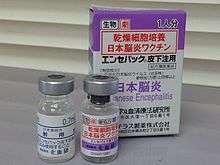Japanese encephalitis vaccine
 Japanese encephalitis vaccine Encevac | |
| Vaccine description | |
|---|---|
| Target disease | Japanese encephalitis |
| Type | Killed/Inactivated |
| Clinical data | |
| MedlinePlus | a607019 |
| ATC code | J07BA02 (WHO) |
| Identifiers | |
| ChemSpider | none |
| | |
Japanese encephalitis vaccine is a vaccine that protects against Japanese encephalitis.[1] The vaccines are more than 90% effective. How long this protection lasts is not clear but its effectiveness appears to decrease over time. Doses are given either by injection into a muscle or just under the skin.[1]
It is recommended as part of routine immunizations in countries where the disease is a problem. One or two doses are given depending on the version of the vaccine. Extra doses are not typically needed in areas where the disease is common. In those with HIV/AIDS or those who are pregnant an inactivated vaccine should be used. Immunization of travellers who plan to spend time outdoors in areas where the disease is common is recommended.[1]
The vaccines are relatively safe. Pain and redness may occur at the site of injection. As of 2015, 15 different vaccines are available: some are based on recombinant DNA techniques, others weakened virus, and others inactivated virus.[1]
The Japanese encephalitis vaccines first became available in the 1930s.[2] It is on the World Health Organization's List of Essential Medicines, the most important medication needed in a basic health system.[3] In the United States it costs between 100 and 200 USD for a course of immunizations.[4]
Efficacy
Randomised control trials on JE-VAX have shown that a two-dose schedule provides significant protection for one year.[5]
History
Japanese encephalitis vaccines first became available in the 1930s. One of them was an inactivated mouse brain-derived vaccine (the Nakayama and/or Beijing-1 strain), made by BIKEN and marketed by Sanofi Pasteur as JE-VAX, until production ceased in 2005. The other was an inactivated vaccine cultivated on primary hamster kidney cells (the Beijing-3 strain). The Beijing-3 strain was the main variant of the vaccine used in the People's Republic of China from 1968 until 2005.[6]
Three second-generation vaccines have entered markets since then: SA14-14-2, IC51 and ChimeriVax-JE. The live-attenuated SA14-14-2 strain was introduced in China in 1988. It is much cheaper than alternative vaccines, and is administered to 20 million Chinese children each year.[5]
A purified, formalin-inactivated, wholevirus vaccine known as IC51 (marketed in Australia and New Zealand as JESPECT and elsewhere as IXIARO) was licensed for use in the United States, Australia, and Europe during the spring of 2009. It is based on a SA14-14-2 strain and cultivated in Vero cells.[6] Another vaccine, a live-attenuated yellow fever-Japanese encephalitis chimeric vaccine known as ChimeriVax-JE (marketed as IMOJEV) was licensed for use in Australia in August 2010[7] and in Thailand in December 2012.[8]
In 2013, an Indian firm, Bharat Biotech International, developed a vaccine by using the Indian strain of the virus collected from the Kolar district in Karnataka by the National Institute of Virology (NIV). Phase III results of human trials were submitted to the Drug authorities of the Government of India and obtained marketing authorization. It is stated by the representatives of the NIV that the success rate of the vaccine is more than 90% and it can be given to children aged between 1–50 years.[9][10]
References
- 1 2 3 4 "Japanese Encephalitis Vaccines: WHO position paper – February 2015." (PDF). Wkly Epidemiol Rec. 90 (9): 69–87. Feb 27, 2015. PMID 25726573.
- ↑ Paulke-Korinek, M; Kollaritsch, H (2008). "Japanese encephalitis and vaccines: past and future prospects.". Wiener klinische Wochenschrift. 120 (19-20 Suppl 4): 15–9. doi:10.1007/s00508-008-1071-9. PMID 19066766.
- ↑ "19th WHO Model List of Essential Medicines (April 2015)" (PDF). WHO. April 2015. Retrieved May 10, 2015.
- ↑ Hamilton, Richart (2015). Tarascon Pocket Pharmacopoeia 2015 Deluxe Lab-Coat Edition. Jones & Bartlett Learning. p. 315. ISBN 9781284057560.
- 1 2 Schiøler KL, Samuel M, Wai KL (2007). "Vaccines for preventing Japanese encephalitis". Cochrane Database Syst Rev (3): CD004263. doi:10.1002/14651858.CD004263.pub2. PMID 17636750.
- 1 2 Halstead SB, Thomas SJ (April 2010). "Japanese encephalitis: new options for active immunization". Clin Infect Dis. 50 (8): 1155–64. doi:10.1086/651271. PMID 20218889.
- ↑ Halstead SB, Thomas SJ (March 2011). "New Japanese encephalitis vaccines: alternatives to production in mouse brain". Expert Rev Vaccines. 10 (3): 355–64. doi:10.1586/erv.11.7. PMID 21434803.
- ↑ "Drug joint venture plans new vaccine". Bangkok Post. 2 November 2013. Retrieved 18 December 2013.
- ↑ JE, Vaccine for (17 December 2012). "India develops indigenous Japanese Encephalitis vaccine". The Times of India. Retrieved 18 December 2012.
- ↑ Japanese Encephalitis, Vaccine (13 September 2012). "India's first Japanese encephalitis vaccine launched". HIndustan Times. Retrieved 18 December 2012.